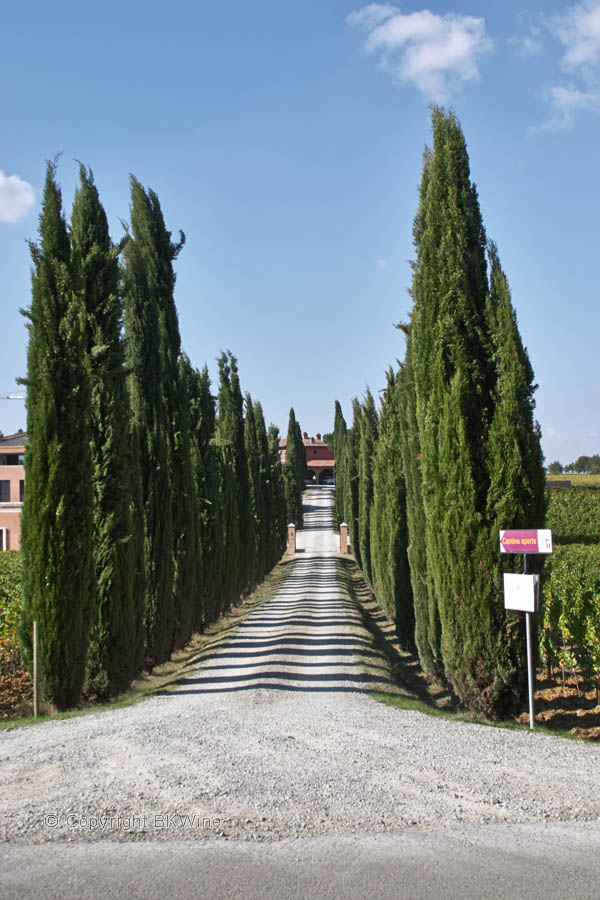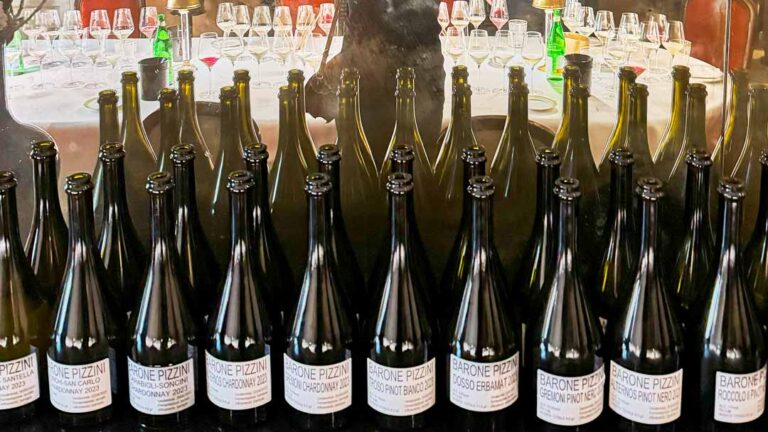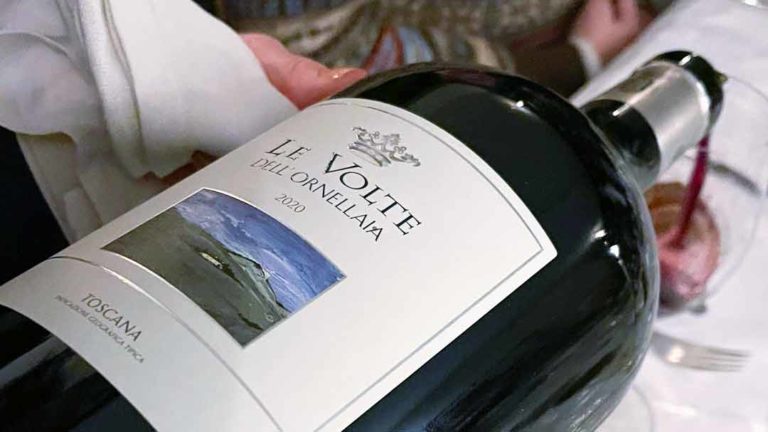BKWine meets one of Tuscany’s leading producers over a wine tasting and lunch
When Federico Carletti’s father said “here, take the keys to the vineyard”, he did not hesitate for a second. He took over the Poliziano vineyards and winery. It had lived a sleepy Italian village life until then. Federico, on the other hand, had big plans for the wines of Montepulciano. When Federico Carletti came to Stockholm BKWine’s Ulf Bengtsson met him over an extensive tasting and lunch. Here is the story and all the wine recommendations.
Poliziano was without a doubt one of my first loves in wine. When my interest in wine took off about ten years ago Poliziano’s Le Stanze was one of the wines that I bought and enjoyed to the full. It was complex, full-bodied, had wonderfully ripe fruit… In short, a totally gulpable wine! Later, my interest in wine led me on to other wine roads, but the memory of Le Stanze has always remained. When Johan Lidby Vinhandel, a wine importer, invited me to a tasting with Poliziano’s entire range, as well as the opportunity to meet Signore Poliziano se stesso, I was therefore not slow to join.

Signore Poliziano’s real name, however, is Federico Carletti. Frederico’s father started the winery in 1961 and ran it until 1980, when Federico took over. “My father was not very interested in wine making, so when I wanted to take over he just said, ‘go ahead, that’s the vineyard, here are the keys!'” The name Frederico’s father had chosen for the winery, Poliziano, is local colloquialism for a person from Montepulciano.
The most famous Poliziano is of course the 15th century poet Angelo Ambrogini, who usually goes by the name of Angelo Poliziano. His most famous poem, Le Stanze figures naturally among Poliziano’s wines, primarily as the wine Le Stanze.
Overall, the company owns over 130 hectares in the Montepulciano area. This splits up in terms of wine as 46 hectares of Vino Nobile di Montepulciano DOCG, 44 hectares of Rosso di Montepulciano DOC and 7 hectares of Cortona DOC. Of the 46 hectares of Vino Nobile di Montepulciano the Asinone vineyard represents 12 hectares. In addition to the vineyards in Montepulciano the company also owns 27 hectares in Maremma. Distributed on wine that means 18 hectares of Morellino di Scansano and 9 hectares of IGT Maremma. These wines are sold under the brand Lohsa.
For me, Poliziano’s wines are distinctive food wines, in a quite affordable price range. The simpler wines start around ten euros and the most expensive reach up to around 35-40 euro. The most expensive one is a vin santo wine that clocks in around 65 euro. It was quite magical though. But the majority of the production is modestly priced wines, definitely food-friendly and typical for their origin. Generally, the wines are on the austere side, elegant and completely dry (ie. no residual sweetness that you can find in, for example, amarone or ripasso). With a focus on elegance, they are fairly light in style or body with high acidity and modest tannins.

Poliziano is also among the wine producers who have reinvented the way they work from the bottom up, from the number of plants per hectare and viticultural practices to the work in the cellar. From being fermented at higher temperatures, using selected yeast and wines with pronounced oak character, the work has gone towards fermentation at lower temperatures, with “natural” yeasts and less oak treatment.
In addition, climate change has meant that they now have to close the top canopy, rather than to open it, to avoid the grapes getting too much sun.
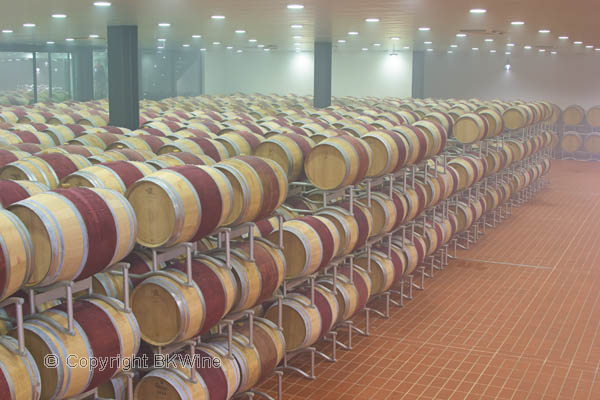
All wines are from Poliziano’s own vineyards. They buy no fruit. Federico Carletti thinks it would destroy typicity. “I want to make the best wine I can starting from the grapes that I can grow in this region.” He think that the region’s own character or typicity should shine through in the wines. He also prefers 100% control of the grape material. All grapes are harvested by hand. Approximately 130 separate micro-vineyards are vinified separately and then blended.
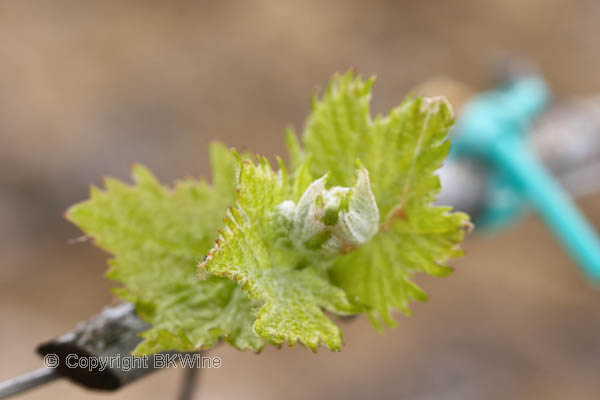
In short the Poliziano wines can be divided into three groups. First, the traditional, made from sangiovese. There are both the “standard” Montepulciano and the more exclusive from the Asinone vineyard. Then you have the Super Tuscans, made from Cabernet Sauvignon and Merlot. Finally, the new projects, the Lohsa wines from Maremma. Our tasting follows that pattern, so the first flight is about sangiovese from Montepulciano.
First flight: Vino Nobile di Montepulciano
First off, the four traditional wines from sangiovese. We start with the entry-level wine 2013 Rosso di Montepulciano, which is not released to the market yet. Good punch in the fruit, warm, palpable acidity, somewhat edgy. Will be nice but a little bit too young now.
Then a 2012 Rosso di Montepulciano (~12 euro; all prices are approximate prices on the Swedish market), the same wine but an earlier vintage. Considerably more maturity. Delicious! Also distinct acidity, but to food it should work excellently.
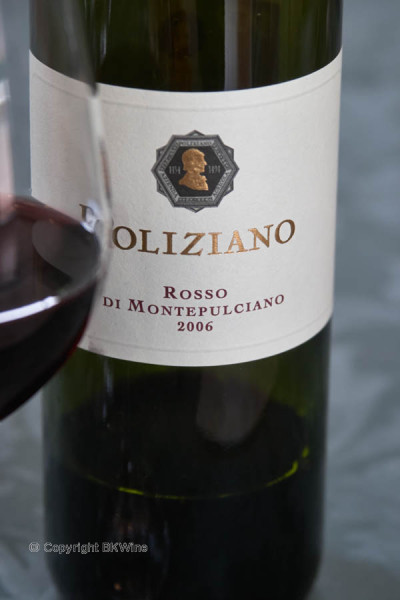
We continue with the 2011 Vino Nobile di Montepulciano Viti Nuove (~16 euro), one notch up in price. It shows. It has darker tones, a different body, a little meaty on the nose. Also very good.
Next is 2011 Vino Nobile di Montepulciano (~21 euro). This was good! High acidity, coffee, ripe dark fruits. Both of these wines have something exotic about them; I find a little banana tones in both wines. Both wines are also distinctively food wines with crisp and clear acidity that needs something like a fat béarnaise sauce to chew into.
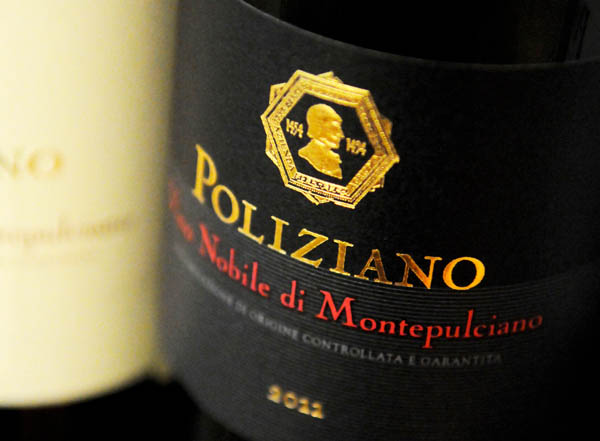
Second flight: Asinone
The second flight is about the Asinone vineyard, the donkey’s back. Asinone is in an exceptionally good location, identified as such after much experimentation, and since 1983 the grapes are vinified separately. Average production is between 20,000 and 30,000 bottles, depending on the vintage.
We tuck into the 2011 Vino Nobile di Montepulciano Asinone (33 euro), which has some beautiful floral notes. Also, high and clear acidity. Delicious wine!
Against this we get a 2010 Vino Nobile di Montepulciano Asinone (36 euro), the previous vintage. This was a better vintage, and one year of ageing has made a big difference for the overall impression.
Federico considers the ageing potential to be 20 to 25 years. So what happens with the Asinone wines with a little age? We get the 2006 Vino Nobile di Montepulciano Asinone and 2000 Vino Nobile di Montepulciano Asinone to see how they compare. My favourite is the latter wine, vintage 2000, still completely intact, although there are a lot of maturity notes. What fantastic wines! Very good ageing potential. If you buy Asinone, do keep a few bottles for a few years, it will pay good dividends.
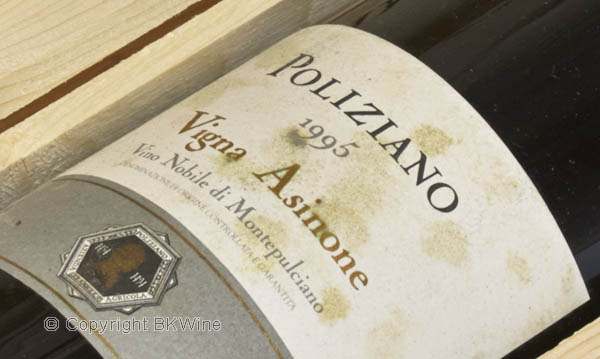
Third flight: Le Stanze
So, at last, the Super Tuscans! We start with 2010 Le Stanze IGT Toscana (future release). Considerably dirtier on the nose! Softer and more full-bodied than the sangiovese wines, more sweetness, more liquorice. Delicious! The grapes are around 80% cabernet sauvignon, the rest is merlot.
The 2010 vintage was totally enjoyable, but against the 2008 Le Stanze, IGT Toscana (38 euro) it does not stand a chance. The two additional years have honed down the worst of the acidity and the wine feels more integrated. Today, I think that the 2008 is the tastings best wine. What I felt ten years ago, I can feel again, and it gives me a great desire to replenish my store of Le Stanze.
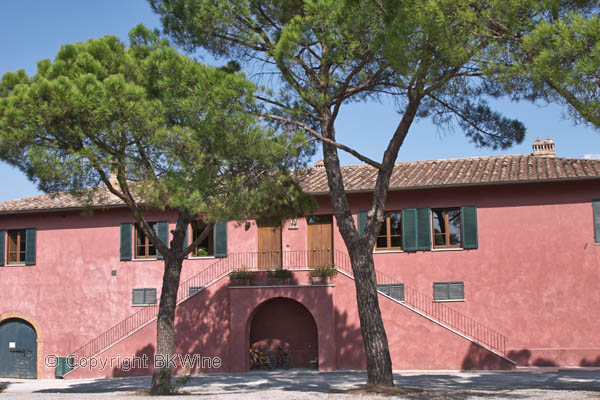
Something quite remarkable is the high yield, between 80 and 90 hectolitres per hectare. Le Stanze was born in 1987, and total production is around 15,000 bottles.
After Le Stanze we get two merlot wines, 2010 In Violas Merlot and 2009 In Violas Merlot, DOC Cortona (2009 is available at 22 euro). The Merlot wines are of a recent date, the first wine was the 2004. Also very good wines, somewhere between Le Stanze and the sangiovese wines in terms of richness and acidity. The 2009 is wonderfully developed, some barrels. Total production about 8000 bottles.
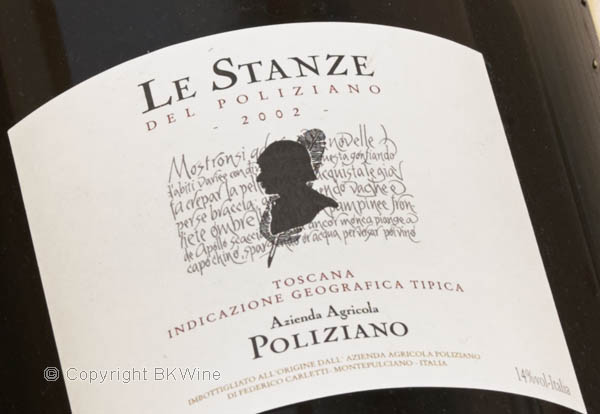
Fourth flight: New areas
Straight south you find Poliziano’s latest project, 27 hectares of vineyards in Maremma. These wines are sold under the Lohsa brand; Osa is a small stream that flows through the area. The 27 hectares are split between 18 hectares of Morellino di Scansano and 9 hectares of Mandrone. It is planted mainly with sangiovese, cabernet sauvignon, petit verdot and some other grapes. The symbol on the label is a large stone that was unearthed in the area.
This will be the last series before the food. We get the 2012 Morellino di Scansano (not available on the market) and 2010, 2008, 2003 and 2001 of Mandone di Lohsa, IGT Maremma Toscana (the 2010 will soon be available at 28 euro).
Mandrone di Lohsa is a Cabernet Sauvignon-based wine, 80% cabernet sauvignon. The rest is not Merlot, as you might expect, but petit verdot / alicante / carignano. The production is between 10,000 and 15,000 bottles. The first vintage was 2001. Fermentation in steel tanks, then 100% new French oak. Yields are significantly lower than for Le Stanze, around 50 hectolitres per hectare. Also really nice wines, I’d like to buy more of these. A little warmer in style and very gulpable.
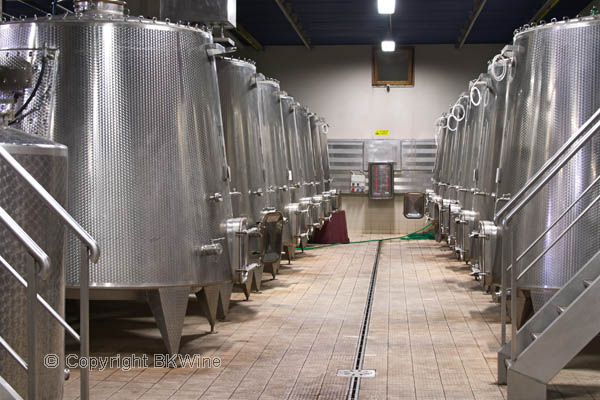
The final flight: sweet
At the end, some sweet wine. We get a 2006 Vin Santo di Montepulciano (not available in retail, only sold to restaurants, in Sweden). Approximately 2,000 bottles are produced annually, since 1995. The main grape is Malvasia, about 90%, the rest Grechetto. After harvest, the grapes are dried for about four months and the wine is then kept for about seven years in cask.
A really lovely wine! No pungent acetone notes, no old winter apples. In the mouth the wine is full-bodied, good acidity, almost refreshing. Really good. A jar of brown sugar, someone says. Very aptly.
Some lessons learned?
So, some lessons learned? It was a very nice tasting that showed the entire range of Poliziano. As noted above, very food-friendly wines. Lovely sangiovese fruit. Excellent super Tuscans in a comfortable price range. Many thanks to Federico Carletti and Johan Lidby Vinhandel a very interesting tasting!
PS; an interesting meeting of hacks…
As a small personal note to finish with I would like to share with you a little amusing story from the tasting. I suspect that one’s own intelligence is not at all times that high. I call these somewhat less flattering incidents for “rapid connection difficulties.” Am I a mental sprinter? As said, not always!
Well then. Once we had sat down at table and Federico Carletti had begun telling his story a slim man in his 60s rushes inside and throws himself down in the seat next to me, quite out of breath. When he has caught his breath a bit he turns to me and says,
“I thought we started at twelve noon!!!”
Beginner’s mistake, I think. We actually started at 11, but it was not a big problem, Federico had not progressed very far in his story.
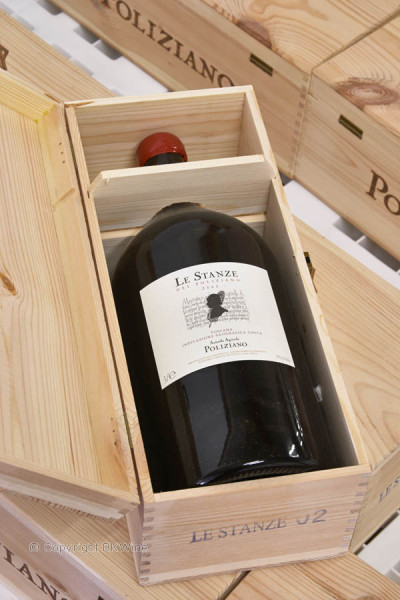
But he turned out to be a pretty nice person! We talked about all sorts of things during the tasting, although it was probably he who did most of the talking. Quite a nice guy, I think. Read-up on things, well-informed, urbane. At some instance, when we taste the Asinone wines I mention, certainly not to boast, but mostly to have a conversation, that I have an unopened 2001 Asinone magnum at home in the cellar. When do you open a magnum bottle anyway? My neighbour at the table then counters by saying,
“In fact, I probably have mostly magnum bottles at home. Magnum bottles and double magnums! ”
At this point I begin to suspect that something is not right. Who is it that has only magnum bottles and double magnums at home? In addition, he also, he mentions, has more double magnum of some specific wine than the producer himself (I have forgotten which producer it was). So who is this neighbour at the table anyway? I do not recognize him from any context that I can remember. A restaurant owner? Hmmm, seems to be a bit too fit to be a restaurant owner.
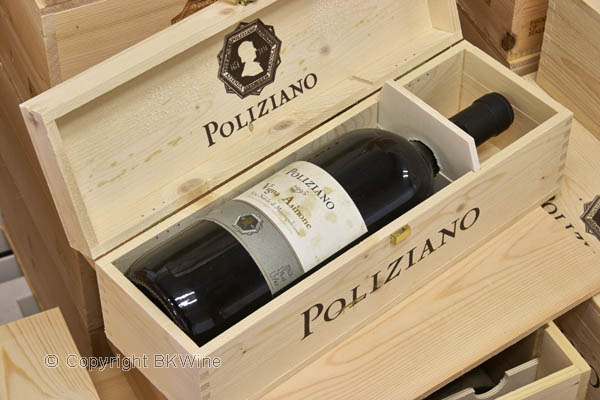
After the tasting, when we get into the lunch, he asks me what I do and I tell him the fundamentals, that I work with finance, have some interest in wine, and also writes some for BKWine and on my own little blog. He nods, BKWine? Ah yes, I know of them!
Since I do not have a foggiest about who this is I ask the same question to him:
“And what do you do?”
First, he does not react, but I see that he is munching on some food. Inexperienced to ask someone who has his mouth full of food a question! But when he’s done chewing he still does not answer, but I suspect that he did not hear me. Sometimes I talk very quietly and not very distinctly. Or did he pretended that he did not hear? So I ask again,
“And what do you do?”
Almost as if he were a bit huffed, he replies, a little lightly,
“I used to write quite a lot about wine in DN [a big Swedish daily paper], but now I write in Allt om Mat [the biggest Swedish food magazine].”
“Ah, nice!” I reply cheerfully. Now in retrospect, I understand that the brain’s automatic sprinkler systems did not really function properly this, since I start thinking feverishly, wrote much about wine in DN? Do I know of someone who wrote a lot about wine in DN? Nooo… I don’t think I do? Or? Who may this be who has previously written much about wine in DN???
I’m lost. Again. But then it happens. When lunch is over and people start to drop off, many people come to my neighbour to greet him. “Nice to see you, Bengt-Göran!”
Then I get it. Bengt-Göran Kronstam!
Ahhh, of course! Oh, intelligence, acumen, deduction… Wake up!!!
Editor’s note: This may require a little bit of an explanation for the non-Swedish readers. It is a little bit like sitting next to, and asking “so what do you do?” to Jancis Robinson, Hugh Johnson, Michel Bettane, or Robert Parker (depending on your country). No other comparisons or similes made with these people of course.
Ulf Bengtsson writes about wine under the pseudonym Red Scream on his blog Red Scream and Riesling, on wine, food, photography and other things that are important in life. Like detective novels, taking long walks in Stockholm and the occasional burst of exercise. He is also on Facebook.
[box type=”info” style=”rounded” border=”full”]Poliziano is one of many exciting wine producers to visit in Tuscany. They are among the wineries that we sometimes feature on the BKWine wine tour program in Tuscany. Come with BKWine on a wine tour to Tuscany and you will meet many exciting wine producers and taste many outstanding wines.
Travel to the world’s wine districts with the experts on wine and the specialist in wine tours.
Wine tours like no others can do.[/box]
Here’s an interview that we did with the winemaker at Poliziano some time ago, Fabio Marchi:
